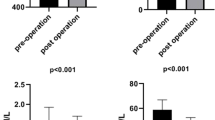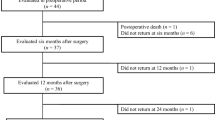Background
The aim of this study is to examine the relationship between oxidative plasma protein and thiol stress and weight loss after laparoscopic adjustable gastric banding (LAGB).
Methods
Plasma protein carbonyl (PCO) concentration as a marker of protein oxidation, plasma thiol (PSH) and erythrocyte glutathione concentration (GSH, major intracellular thiol), as an antioxidant and metabolic markers, such as Homeostatic Model Assessment — Insulin resistance (HOMA-IR), BMI and plasma lipids were determined in morbidly obese patients (n 22, mean age 34.7 ±11 years, BMI 48.4 ±6.4 kg/m2) at baseline and 1 and 6 months after operation. Baseline levels in patients were also compared with the levels in agematched controls (n 20, BMI 21.3 ±1.8 kg/m2). Plasma PCO and thiols and erythrocyte GSH concentrations were determined spectrophotometrically.
Results
Plasma PCO were significantly higher and plasma and erythrocyte thiol concentrations were significantly lower in morbidly obese patients than in controls (for each comparison, P<0.01). BMI, plasma triglycerides and HOMA-IR were positively correlated with plasma PCO and negatively correlated with plasma P-SH and erythrocyte GSH (for each comparison, P<0.01). Plasma HDL-cholesterol levels were positively correlated with plasma erythrocyte GSH (r=0.405, P<0.01) and negative correlated with plasma PCO (r=−0.273, P<0.01). One and 6 months after the LAGB operation, total weight loss was 13.2 ±6.3 and 35.5 ±7.5 kg, respectively. Plasma PCO concentrations were decreased and P-SH and erythrocyte GSH concentrations were elevated following weight loss (for each, P<0.01). Only plasma P-SH levels were restored to the control levels 6 months after LAGB.
Conclusions
Obesity and insulin resistance appear to be associated with plasma protein oxidation and thiol concentrations. Protein and thiol oxidative stress was improved by weight loss after LAGB in the short-term.
Similar content being viewed by others
References
Halliwell B, Gutteridge J. Free Radicals in Biology and Medicine. NY: Oxford Univ Press, 1999.
Berlett BS, Stadtman ER. Protein oxidation in aging, disease, and oxidative stress. J Biol Chem 1997; 272: 20313–6.
Dean RT, Fu S, Stocker R et al. Biochemistry and pathology of radical-mediated protein oxidation. Biochem J 1997; 324: 1–18.
Dalle-Donne I, Rossi R, Giustarini D et al. Protein carbonyl groups as biomarkers of oxidative stress. Clin Chim Acta 2003; 329: 23–38.
Giustarini D, Dalle-Donne I, Colombo R et al. Protein glutathionylation in erythrocytes. Clin Chem 2003; 49: 327–30.
Anderson ME, Meister A. Glutathione monoesters. Anal Biochem 1989; 183: 16–20.
Konukoglu D, Serin O, Turhan MS. Plasma leptin and its relationship with lipid peroxidation and nitric oxide in obese female patients with or without hypertension. Arch Med Res 2006; 37: 602–6.
Gastrointestinal surgery for severe obesity: National Institutes of Health Consensus Development Conference Draft Statement. Obes Surg 1991; 1: 257–65.
Reznick AZ, Packer L. Oxidative damage to proteins: spectrophotometric method for carbonyl assay. Methods Enzymol 1994; 233: 357–63.
Hu ML. Measurement of protein thiol groups and glutathione in plasma. Methods Enzymol 1994; 233: 381–5.
Beutler E, Duran O, Kelly MB. Improved method for the determination of blood glutathione. J Lab Clin Med 1963; 61: 882–8.
Valko M, Leibfritz D, Moncol J et al. Free radicals and antioxidants in normal physiological functions and human disease. Int J Biochem Cell Biol 2007; 39: 44–84.
Minuz P, Fava C, Cominacini L. Oxidative stress, antioxidants, and vascular damage. Br J Clin Pharmacol 2006; 61: 774–7.
Stadtman ER, Levine RL. Protein oxidation. Ann NY Acad Sci 2000; 899: 191–208.
Van Gaal LF, Mertens IL, De Block CE. Mechanisms linking obesity with cardiovascular disease. Nature 2006; 444: 875–80.
Eisenberg D, Duffy AJ, Bell RL. Update on obesity surgery. World J Gastroenterol 2006; 12: 3196–203.
Shacher E. Quantification and significance of protein oxidation in biological samples. Drug Metab Rev 2000; 32: 307–26.
Himmelfarb J, McMonagle E, McMenamin E. Plasma protein thiol oxidation and carbonyl formation in chronic renal failure. Kidney Int 2000; 58: 2571–8.
Meister A, Anderson ME. Glutathione. Ann Rev Biochem 1983; 52: 711–60.
Olusi SO. Obesity is an independent risk factor for plasma lipid peroxidation and depletion of erythrocyte cytoprotectic enzymes in humans. Int J Obes 2002; 26: 1159–64.
Atabek ME, Keskin M, Yazici C et al. Protein oxidation in obesity and insulin resistance. Eur J Pediatr 2006; 165: 753–6.
Ozaydin A, Onaran I, Yesim TE et al. Increased glutathione conjugate transport: a possible compensatory protection mechanism against oxidative stress in obesity? Int J Obes 2006; 30: 134–40.
Khan NI, Naz L, Yasmeen G. Obesity: an independent risk factor for systemic oxidative stress. Pak J Pharm Sci 2006; 19: 62–5.
Grimsrud PA, Picklo MJ Sr, Griffin TJ et al. Carbonylation of adipose proteins in obesity and insulin resistance: Identification of adipocyte fatty acid-binding protein as a cellular target of 4-hydroxynonenal. Mol Cell Proteomics 2007; 6: 624–37.
Keaney JF Jr, Larson MG, Vasan RS et al. Framingham Study. Obesity and systemic oxidative stress: clinical correlates of oxidative stress in the Framingham Study. Arterioscler Thromb Vasc Biol 2003; 23: 434–9.
Ritt M, Piza H, Rhomberg M et al. Metabolic risk factors in formerly obese women — effects of a pronounced weight loss by gastric band operation compared with weight loss by diet alone. Diabetes Obes Metab 2005; 7: 216–22.
Melissas J, Malliaraki N, Papadakis JA et al. Plasma antioxidant capacity in morbidly obese patients before and after weight loss. Obes Surg 2006; 16: 314–20.
Faber P, Johnstone AM, Gibney ER et al. The effect of rate of weight loss on erythrocyte glutathione concentration and synthesis in healthy obese men. Clin Sci 2002; 102: 569–77.
Uzun H, Zengin K, Taskin M et al. Changes in leptin, plasminogen activator factor and oxidative stress in morbidly obese patients following open and laparoscopic Swedish adjustable gastric banding. Obes Surg 2004; 14: 659–65.
Author information
Authors and Affiliations
Corresponding author
Rights and permissions
About this article
Cite this article
Uzun, H., Konukoglu, D., Gelisgen, R. et al. Plasma Protein Carbonyl and Thiol Stress Before and After Laparoscopic Gastric Banding in Morbidly Obese Patients. OBES SURG 17, 1367–1373 (2007). https://doi.org/10.1007/s11695-007-9242-8
Received:
Accepted:
Published:
Issue Date:
DOI: https://doi.org/10.1007/s11695-007-9242-8




